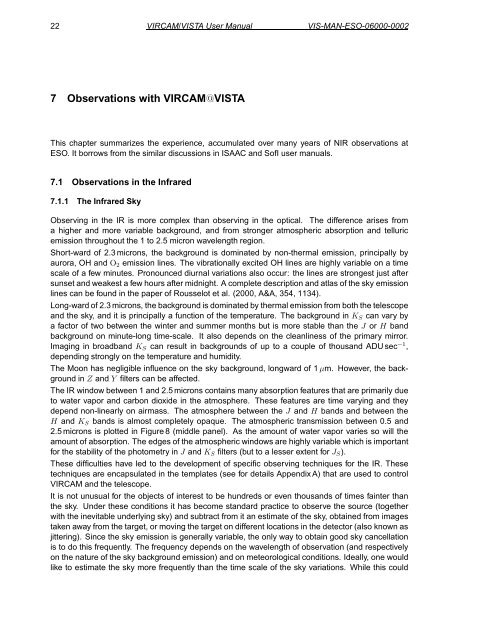You also want an ePaper? Increase the reach of your titles
YUMPU automatically turns print PDFs into web optimized ePapers that Google loves.
22 VIRCAM/<strong>VISTA</strong> <strong>User</strong> <strong>Manual</strong> VIS-MAN-<strong>ESO</strong>-06000-0002<br />
7 Observations with VIRCAM@<strong>VISTA</strong><br />
This chapter summarizes the experience, accumulated over many years of NIR observations at<br />
<strong>ESO</strong>. It borrows from the similar discussions in ISAAC and SofI user manuals.<br />
7.1 Observations in the Infrared<br />
7.1.1 The Infrared Sky<br />
Observing in the IR is more complex than observing in the optical. The difference arises from<br />
a higher and more variable background, and from stronger atmospheric absorption and telluric<br />
emission throughout the 1 to 2.5 micron wavelength region.<br />
Short-ward of 2.3 microns, the background is dominated by non-thermal emission, principally by<br />
aurora, OH and O2 emission lines. The vibrationally excited OH lines are highly variable on a time<br />
scale of a few minutes. Pronounced diurnal variations also occur: the lines are strongest just after<br />
sunset and weakest a few hours after midnight. A complete description and atlas of the sky emission<br />
lines can be found in the paper of Rousselot et al. (2000, A&A, 354, 1134).<br />
Long-ward of 2.3 microns, the background is dominated by thermal emission from both the telescope<br />
and the sky, and it is principally a function of the temperature. The background in KS can vary by<br />
a factor of two between the winter and summer months but is more stable than the J or H band<br />
background on minute-long time-scale. It also depends on the cleanliness of the primary mirror.<br />
Imaging in broadband KS can result in backgrounds of up to a couple of thousand ADU sec −1 ,<br />
depending strongly on the temperature and humidity.<br />
The Moon has negligible influence on the sky background, longward of 1 µm. However, the background<br />
in Z and Y filters can be affected.<br />
The IR window between 1 and 2.5 microns contains many absorption features that are primarily due<br />
to water vapor and carbon dioxide in the atmosphere. These features are time varying and they<br />
depend non-linearly on airmass. The atmosphere between the J and H bands and between the<br />
H and KS bands is almost completely opaque. The atmospheric transmission between 0.5 and<br />
2.5 microns is plotted in Figure 8 (middle panel). As the amount of water vapor varies so will the<br />
amount of absorption. The edges of the atmospheric windows are highly variable which is important<br />
for the stability of the photometry in J and KS filters (but to a lesser extent for JS).<br />
These difficulties have led to the development of specific observing techniques for the IR. These<br />
techniques are encapsulated in the templates (see for details Appendix A) that are used to control<br />
VIRCAM and the telescope.<br />
It is not unusual for the objects of interest to be hundreds or even thousands of times fainter than<br />
the sky. Under these conditions it has become standard practice to observe the source (together<br />
with the inevitable underlying sky) and subtract from it an estimate of the sky, obtained from images<br />
taken away from the target, or moving the target on different locations in the detector (also known as<br />
jittering). Since the sky emission is generally variable, the only way to obtain good sky cancellation<br />
is to do this frequently. The frequency depends on the wavelength of observation (and respectively<br />
on the nature of the sky background emission) and on meteorological conditions. Ideally, one would<br />
like to estimate the sky more frequently than the time scale of the sky variations. While this could

















